Leadership, Management & Operations: Theories and Application Report
VerifiedAdded on 2020/10/22
|15
|4459
|82
Report
AI Summary
This report provides a comprehensive overview of the differences between leaders and managers, exploring their distinct roles, functions, and leadership styles within an organizational context. It delves into various leadership approaches, including systems, contingency, and situational leadership, evaluating their strengths and weaknesses. The report also highlights the importance of operations management, discussing its approaches such as Six Sigma and Total Quality Management, and assessing external factors that can impact operational efficiency. Through an analysis of these concepts, the report aims to provide insights into how effective leadership and management practices can enhance operational performance and contribute to achieving business objectives. The report also evaluates the different theories and approaches of leadership to increase the efficiencies of operational management.
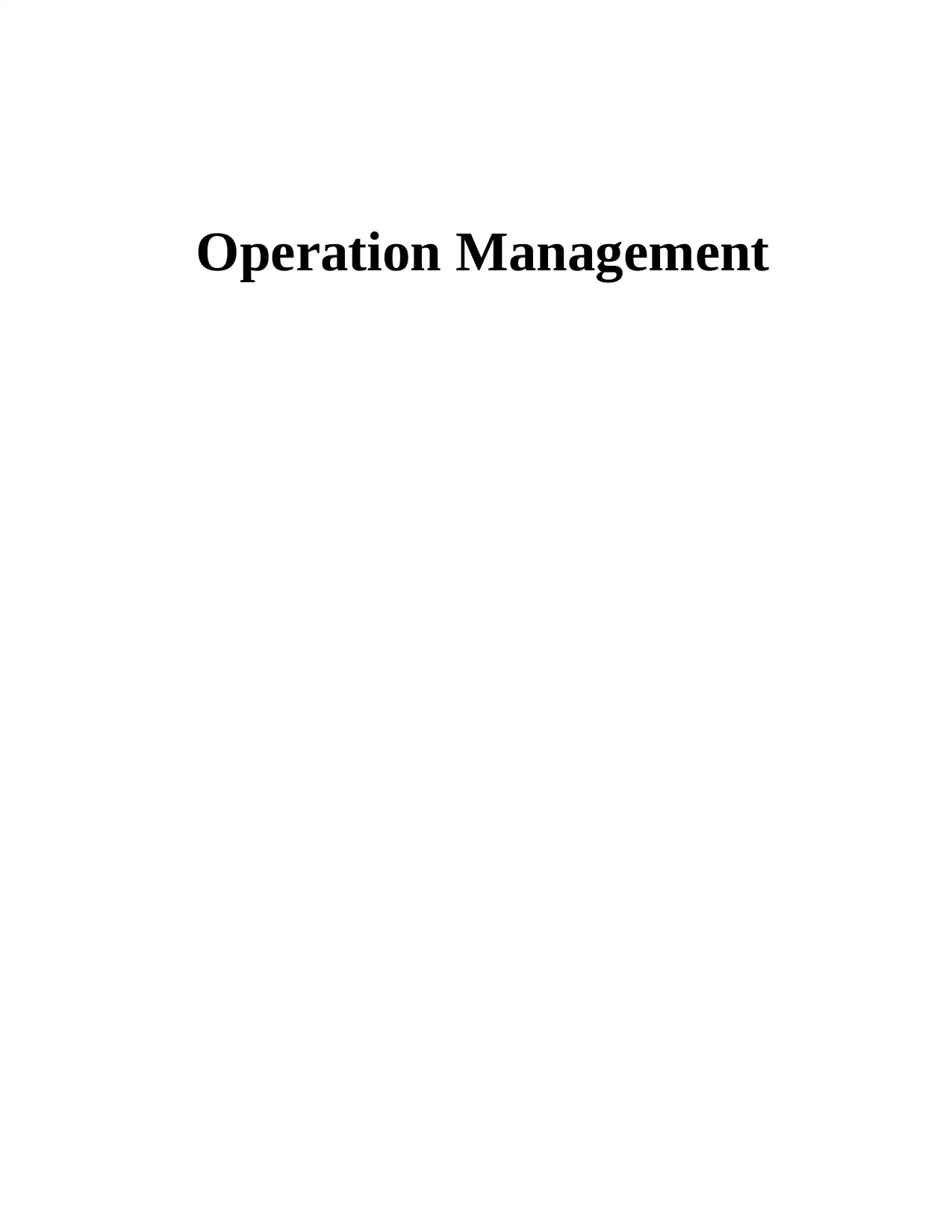
Operation Management
Paraphrase This Document
Need a fresh take? Get an instant paraphrase of this document with our AI Paraphraser
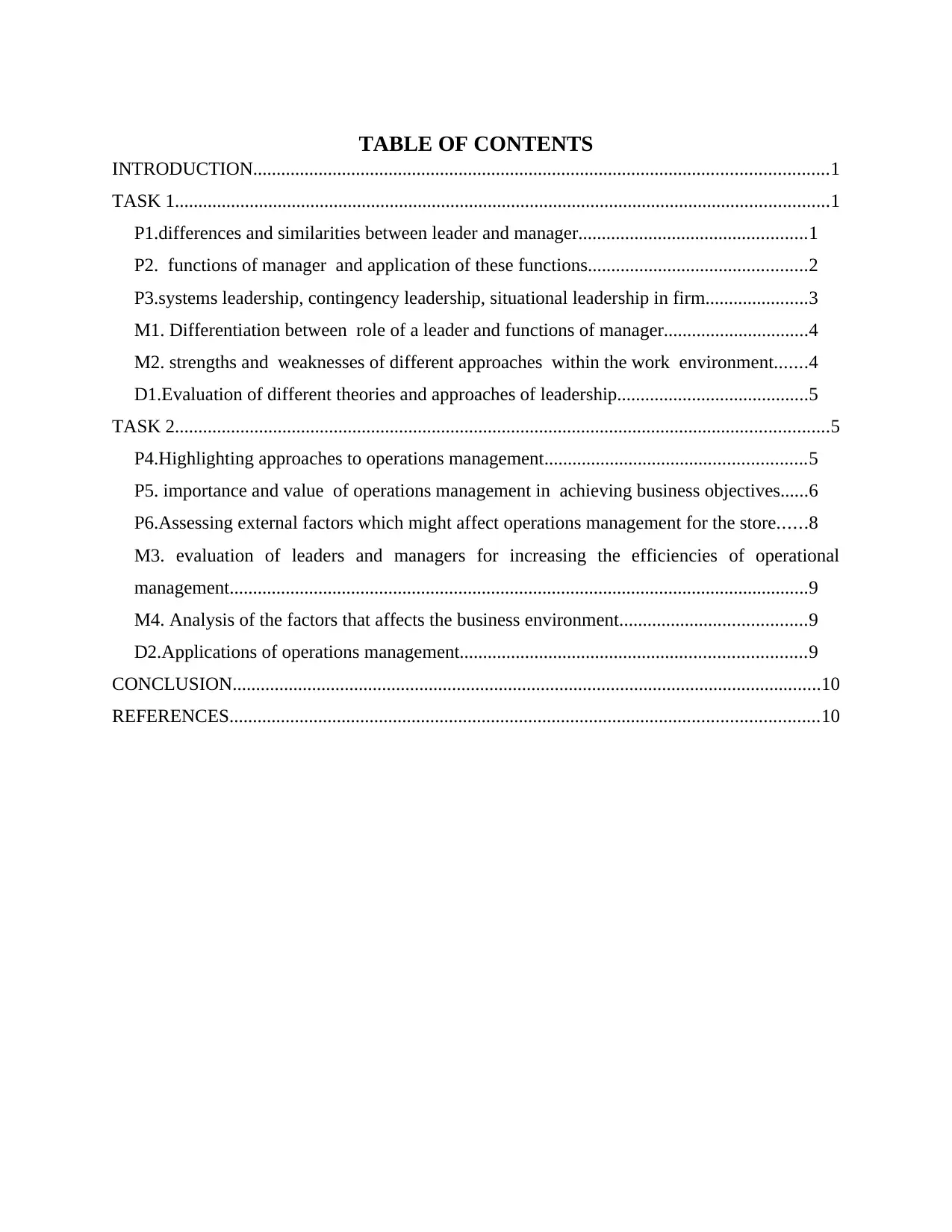
TABLE OF CONTENTS
INTRODUCTION...........................................................................................................................1
TASK 1............................................................................................................................................1
P1.differences and similarities between leader and manager.................................................1
P2. functions of manager and application of these functions...............................................2
P3.systems leadership, contingency leadership, situational leadership in firm......................3
M1. Differentiation between role of a leader and functions of manager...............................4
M2. strengths and weaknesses of different approaches within the work environment.......4
D1.Evaluation of different theories and approaches of leadership.........................................5
TASK 2............................................................................................................................................5
P4.Highlighting approaches to operations management........................................................5
P5. importance and value of operations management in achieving business objectives......6
P6.Assessing external factors which might affect operations management for the store......8
M3. evaluation of leaders and managers for increasing the efficiencies of operational
management............................................................................................................................9
M4. Analysis of the factors that affects the business environment........................................9
D2.Applications of operations management..........................................................................9
CONCLUSION..............................................................................................................................10
REFERENCES..............................................................................................................................10
INTRODUCTION...........................................................................................................................1
TASK 1............................................................................................................................................1
P1.differences and similarities between leader and manager.................................................1
P2. functions of manager and application of these functions...............................................2
P3.systems leadership, contingency leadership, situational leadership in firm......................3
M1. Differentiation between role of a leader and functions of manager...............................4
M2. strengths and weaknesses of different approaches within the work environment.......4
D1.Evaluation of different theories and approaches of leadership.........................................5
TASK 2............................................................................................................................................5
P4.Highlighting approaches to operations management........................................................5
P5. importance and value of operations management in achieving business objectives......6
P6.Assessing external factors which might affect operations management for the store......8
M3. evaluation of leaders and managers for increasing the efficiencies of operational
management............................................................................................................................9
M4. Analysis of the factors that affects the business environment........................................9
D2.Applications of operations management..........................................................................9
CONCLUSION..............................................................................................................................10
REFERENCES..............................................................................................................................10
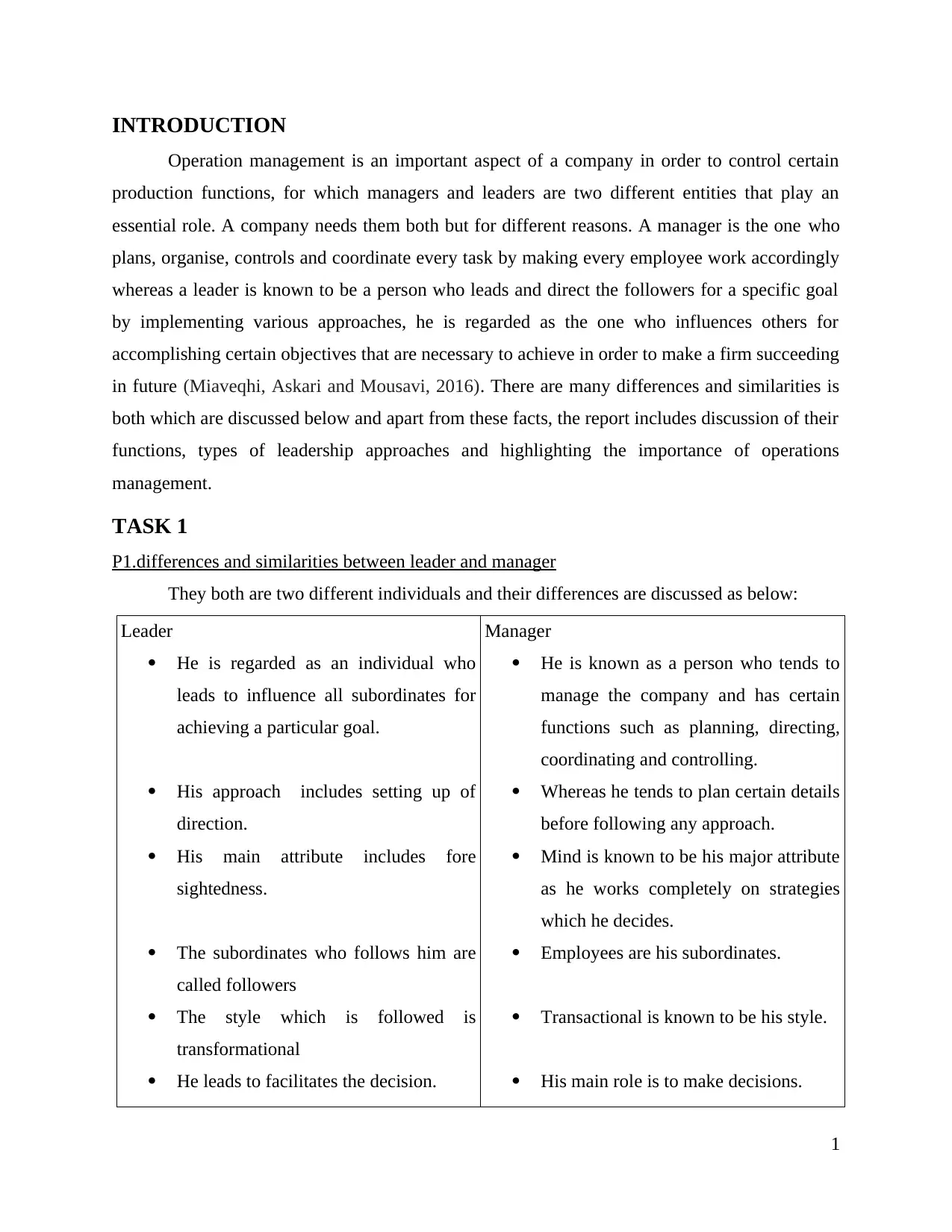
INTRODUCTION
Operation management is an important aspect of a company in order to control certain
production functions, for which managers and leaders are two different entities that play an
essential role. A company needs them both but for different reasons. A manager is the one who
plans, organise, controls and coordinate every task by making every employee work accordingly
whereas a leader is known to be a person who leads and direct the followers for a specific goal
by implementing various approaches, he is regarded as the one who influences others for
accomplishing certain objectives that are necessary to achieve in order to make a firm succeeding
in future (Miaveqhi, Askari and Mousavi, 2016). There are many differences and similarities is
both which are discussed below and apart from these facts, the report includes discussion of their
functions, types of leadership approaches and highlighting the importance of operations
management.
TASK 1
P1.differences and similarities between leader and manager
They both are two different individuals and their differences are discussed as below:
Leader
He is regarded as an individual who
leads to influence all subordinates for
achieving a particular goal.
His approach includes setting up of
direction.
His main attribute includes fore
sightedness.
The subordinates who follows him are
called followers
The style which is followed is
transformational
He leads to facilitates the decision.
Manager
He is known as a person who tends to
manage the company and has certain
functions such as planning, directing,
coordinating and controlling.
Whereas he tends to plan certain details
before following any approach.
Mind is known to be his major attribute
as he works completely on strategies
which he decides.
Employees are his subordinates.
Transactional is known to be his style.
His main role is to make decisions.
1
Operation management is an important aspect of a company in order to control certain
production functions, for which managers and leaders are two different entities that play an
essential role. A company needs them both but for different reasons. A manager is the one who
plans, organise, controls and coordinate every task by making every employee work accordingly
whereas a leader is known to be a person who leads and direct the followers for a specific goal
by implementing various approaches, he is regarded as the one who influences others for
accomplishing certain objectives that are necessary to achieve in order to make a firm succeeding
in future (Miaveqhi, Askari and Mousavi, 2016). There are many differences and similarities is
both which are discussed below and apart from these facts, the report includes discussion of their
functions, types of leadership approaches and highlighting the importance of operations
management.
TASK 1
P1.differences and similarities between leader and manager
They both are two different individuals and their differences are discussed as below:
Leader
He is regarded as an individual who
leads to influence all subordinates for
achieving a particular goal.
His approach includes setting up of
direction.
His main attribute includes fore
sightedness.
The subordinates who follows him are
called followers
The style which is followed is
transformational
He leads to facilitates the decision.
Manager
He is known as a person who tends to
manage the company and has certain
functions such as planning, directing,
coordinating and controlling.
Whereas he tends to plan certain details
before following any approach.
Mind is known to be his major attribute
as he works completely on strategies
which he decides.
Employees are his subordinates.
Transactional is known to be his style.
His main role is to make decisions.
1
⊘ This is a preview!⊘
Do you want full access?
Subscribe today to unlock all pages.

Trusted by 1+ million students worldwide
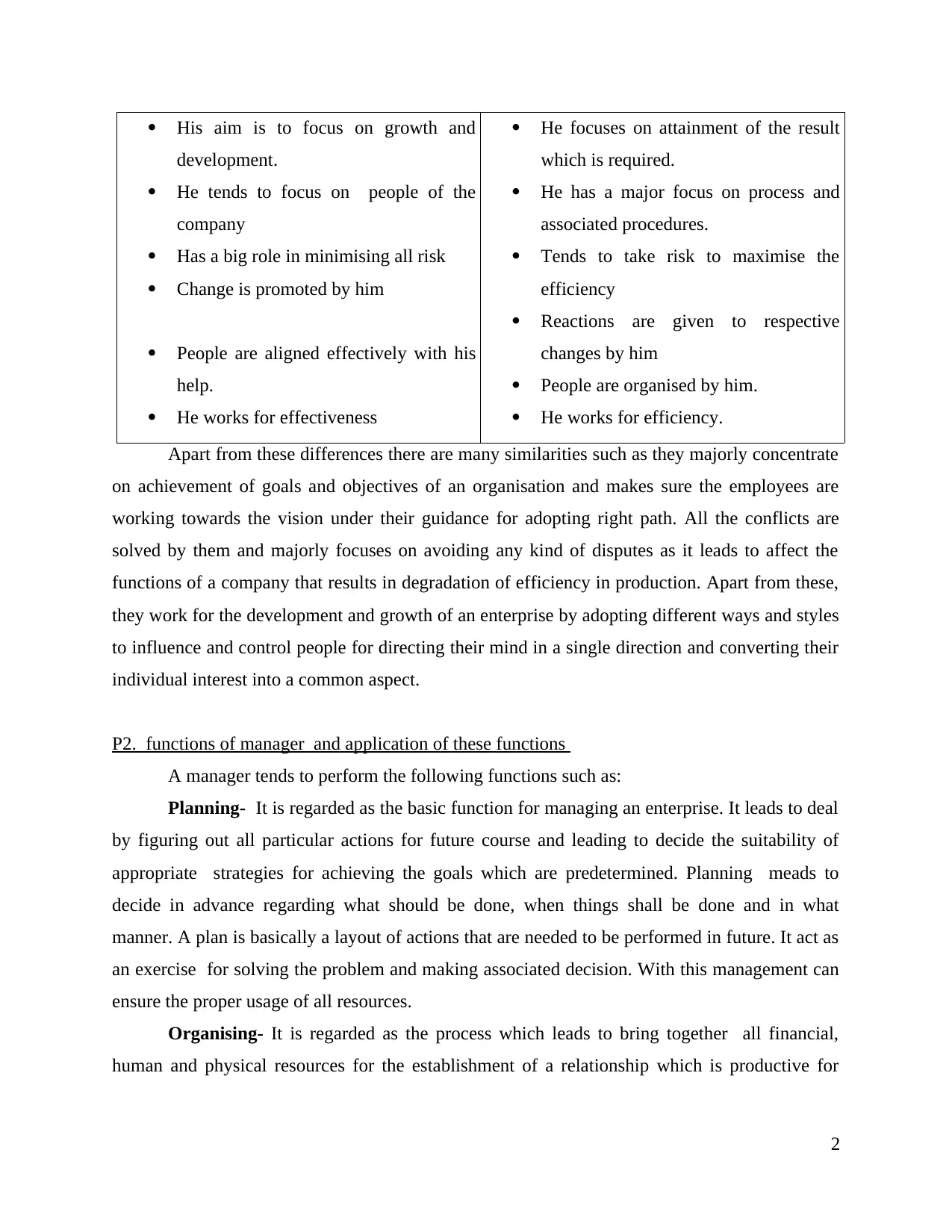
His aim is to focus on growth and
development.
He tends to focus on people of the
company
Has a big role in minimising all risk
Change is promoted by him
People are aligned effectively with his
help.
He works for effectiveness
He focuses on attainment of the result
which is required.
He has a major focus on process and
associated procedures.
Tends to take risk to maximise the
efficiency
Reactions are given to respective
changes by him
People are organised by him.
He works for efficiency.
Apart from these differences there are many similarities such as they majorly concentrate
on achievement of goals and objectives of an organisation and makes sure the employees are
working towards the vision under their guidance for adopting right path. All the conflicts are
solved by them and majorly focuses on avoiding any kind of disputes as it leads to affect the
functions of a company that results in degradation of efficiency in production. Apart from these,
they work for the development and growth of an enterprise by adopting different ways and styles
to influence and control people for directing their mind in a single direction and converting their
individual interest into a common aspect.
P2. functions of manager and application of these functions
A manager tends to perform the following functions such as:
Planning- It is regarded as the basic function for managing an enterprise. It leads to deal
by figuring out all particular actions for future course and leading to decide the suitability of
appropriate strategies for achieving the goals which are predetermined. Planning meads to
decide in advance regarding what should be done, when things shall be done and in what
manner. A plan is basically a layout of actions that are needed to be performed in future. It act as
an exercise for solving the problem and making associated decision. With this management can
ensure the proper usage of all resources.
Organising- It is regarded as the process which leads to bring together all financial,
human and physical resources for the establishment of a relationship which is productive for
2
development.
He tends to focus on people of the
company
Has a big role in minimising all risk
Change is promoted by him
People are aligned effectively with his
help.
He works for effectiveness
He focuses on attainment of the result
which is required.
He has a major focus on process and
associated procedures.
Tends to take risk to maximise the
efficiency
Reactions are given to respective
changes by him
People are organised by him.
He works for efficiency.
Apart from these differences there are many similarities such as they majorly concentrate
on achievement of goals and objectives of an organisation and makes sure the employees are
working towards the vision under their guidance for adopting right path. All the conflicts are
solved by them and majorly focuses on avoiding any kind of disputes as it leads to affect the
functions of a company that results in degradation of efficiency in production. Apart from these,
they work for the development and growth of an enterprise by adopting different ways and styles
to influence and control people for directing their mind in a single direction and converting their
individual interest into a common aspect.
P2. functions of manager and application of these functions
A manager tends to perform the following functions such as:
Planning- It is regarded as the basic function for managing an enterprise. It leads to deal
by figuring out all particular actions for future course and leading to decide the suitability of
appropriate strategies for achieving the goals which are predetermined. Planning meads to
decide in advance regarding what should be done, when things shall be done and in what
manner. A plan is basically a layout of actions that are needed to be performed in future. It act as
an exercise for solving the problem and making associated decision. With this management can
ensure the proper usage of all resources.
Organising- It is regarded as the process which leads to bring together all financial,
human and physical resources for the establishment of a relationship which is productive for
2
Paraphrase This Document
Need a fresh take? Get an instant paraphrase of this document with our AI Paraphraser
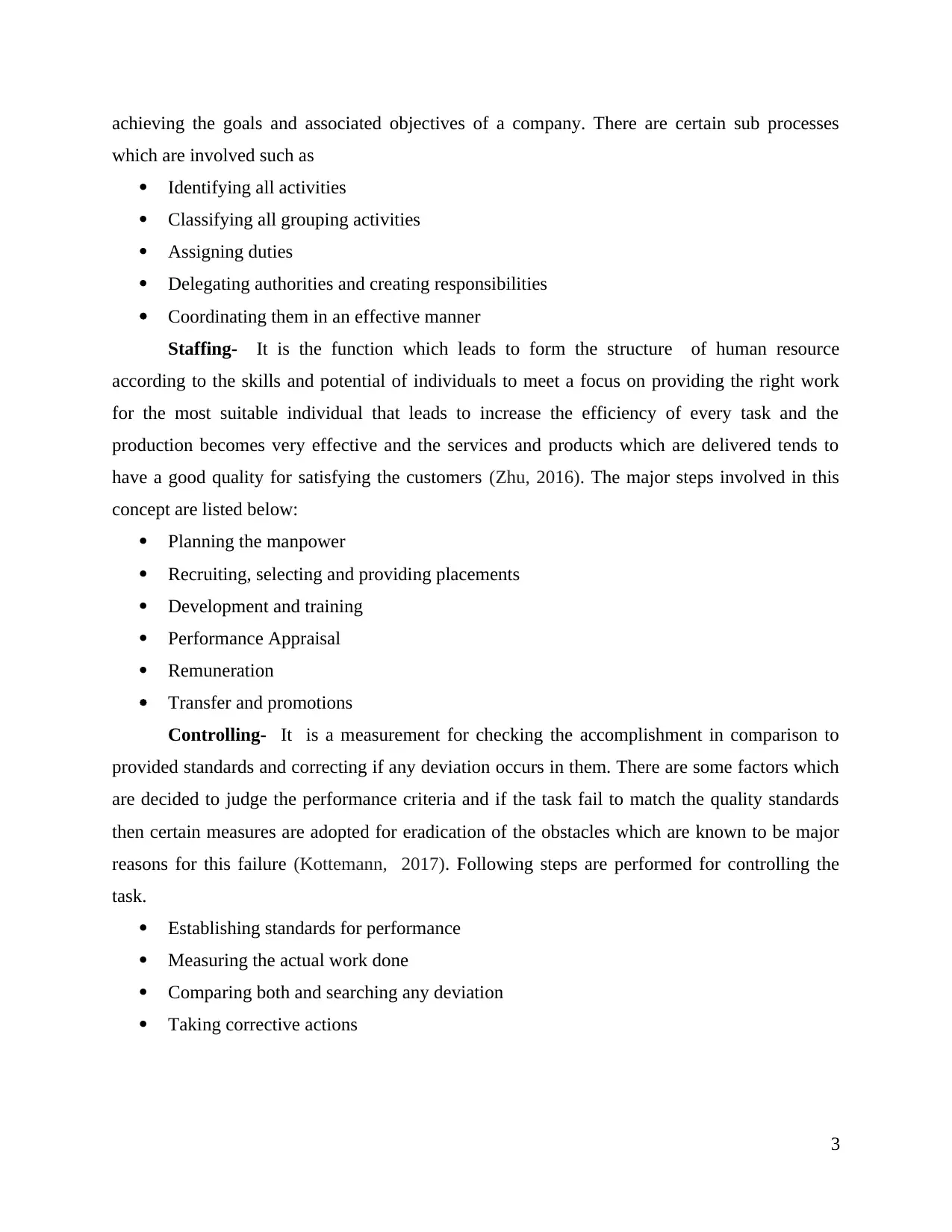
achieving the goals and associated objectives of a company. There are certain sub processes
which are involved such as
Identifying all activities
Classifying all grouping activities
Assigning duties
Delegating authorities and creating responsibilities
Coordinating them in an effective manner
Staffing- It is the function which leads to form the structure of human resource
according to the skills and potential of individuals to meet a focus on providing the right work
for the most suitable individual that leads to increase the efficiency of every task and the
production becomes very effective and the services and products which are delivered tends to
have a good quality for satisfying the customers (Zhu, 2016). The major steps involved in this
concept are listed below:
Planning the manpower
Recruiting, selecting and providing placements
Development and training
Performance Appraisal
Remuneration
Transfer and promotions
Controlling- It is a measurement for checking the accomplishment in comparison to
provided standards and correcting if any deviation occurs in them. There are some factors which
are decided to judge the performance criteria and if the task fail to match the quality standards
then certain measures are adopted for eradication of the obstacles which are known to be major
reasons for this failure (Kottemann, 2017). Following steps are performed for controlling the
task.
Establishing standards for performance
Measuring the actual work done
Comparing both and searching any deviation
Taking corrective actions
3
which are involved such as
Identifying all activities
Classifying all grouping activities
Assigning duties
Delegating authorities and creating responsibilities
Coordinating them in an effective manner
Staffing- It is the function which leads to form the structure of human resource
according to the skills and potential of individuals to meet a focus on providing the right work
for the most suitable individual that leads to increase the efficiency of every task and the
production becomes very effective and the services and products which are delivered tends to
have a good quality for satisfying the customers (Zhu, 2016). The major steps involved in this
concept are listed below:
Planning the manpower
Recruiting, selecting and providing placements
Development and training
Performance Appraisal
Remuneration
Transfer and promotions
Controlling- It is a measurement for checking the accomplishment in comparison to
provided standards and correcting if any deviation occurs in them. There are some factors which
are decided to judge the performance criteria and if the task fail to match the quality standards
then certain measures are adopted for eradication of the obstacles which are known to be major
reasons for this failure (Kottemann, 2017). Following steps are performed for controlling the
task.
Establishing standards for performance
Measuring the actual work done
Comparing both and searching any deviation
Taking corrective actions
3
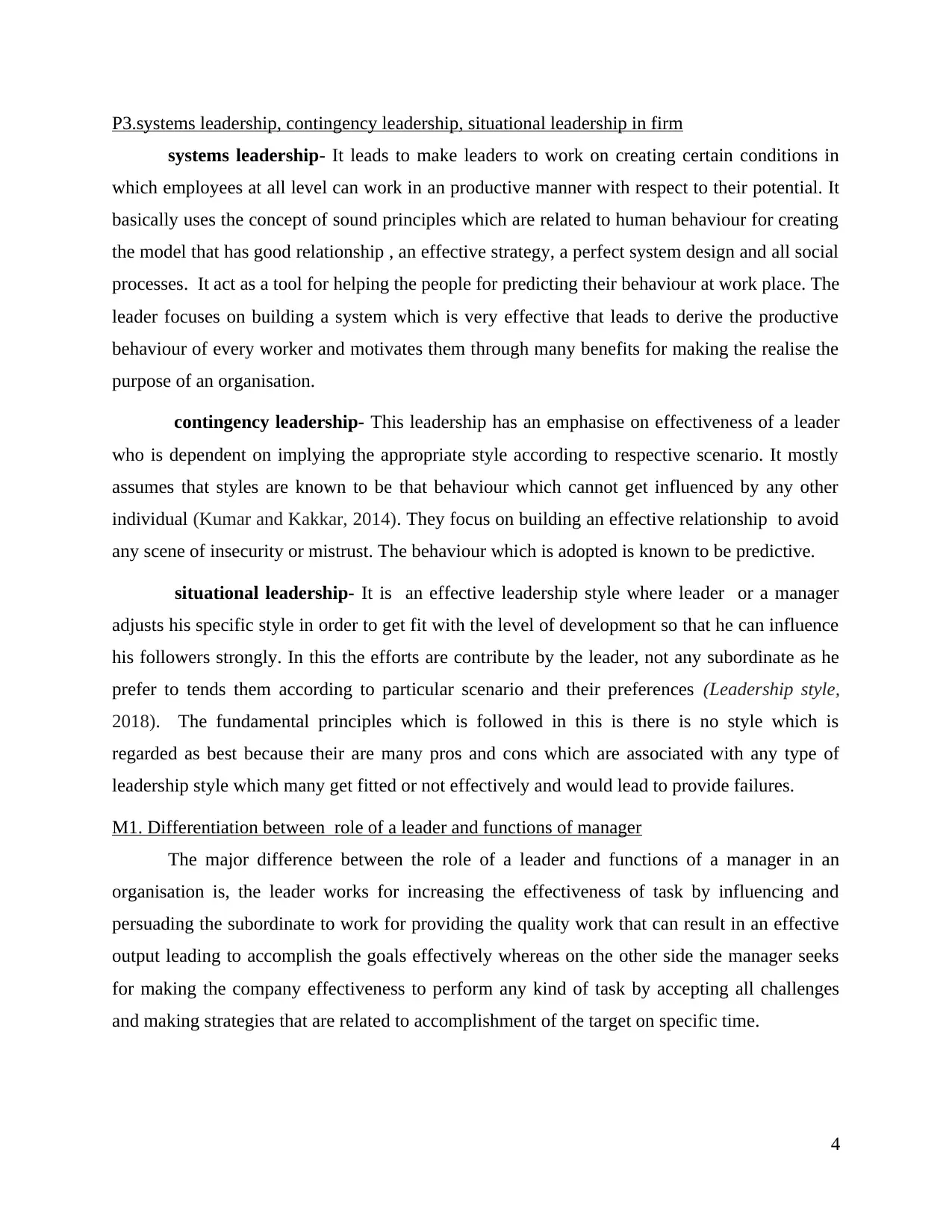
P3.systems leadership, contingency leadership, situational leadership in firm
systems leadership- It leads to make leaders to work on creating certain conditions in
which employees at all level can work in an productive manner with respect to their potential. It
basically uses the concept of sound principles which are related to human behaviour for creating
the model that has good relationship , an effective strategy, a perfect system design and all social
processes. It act as a tool for helping the people for predicting their behaviour at work place. The
leader focuses on building a system which is very effective that leads to derive the productive
behaviour of every worker and motivates them through many benefits for making the realise the
purpose of an organisation.
contingency leadership- This leadership has an emphasise on effectiveness of a leader
who is dependent on implying the appropriate style according to respective scenario. It mostly
assumes that styles are known to be that behaviour which cannot get influenced by any other
individual (Kumar and Kakkar, 2014). They focus on building an effective relationship to avoid
any scene of insecurity or mistrust. The behaviour which is adopted is known to be predictive.
situational leadership- It is an effective leadership style where leader or a manager
adjusts his specific style in order to get fit with the level of development so that he can influence
his followers strongly. In this the efforts are contribute by the leader, not any subordinate as he
prefer to tends them according to particular scenario and their preferences (Leadership style,
2018). The fundamental principles which is followed in this is there is no style which is
regarded as best because their are many pros and cons which are associated with any type of
leadership style which many get fitted or not effectively and would lead to provide failures.
M1. Differentiation between role of a leader and functions of manager
The major difference between the role of a leader and functions of a manager in an
organisation is, the leader works for increasing the effectiveness of task by influencing and
persuading the subordinate to work for providing the quality work that can result in an effective
output leading to accomplish the goals effectively whereas on the other side the manager seeks
for making the company effectiveness to perform any kind of task by accepting all challenges
and making strategies that are related to accomplishment of the target on specific time.
4
systems leadership- It leads to make leaders to work on creating certain conditions in
which employees at all level can work in an productive manner with respect to their potential. It
basically uses the concept of sound principles which are related to human behaviour for creating
the model that has good relationship , an effective strategy, a perfect system design and all social
processes. It act as a tool for helping the people for predicting their behaviour at work place. The
leader focuses on building a system which is very effective that leads to derive the productive
behaviour of every worker and motivates them through many benefits for making the realise the
purpose of an organisation.
contingency leadership- This leadership has an emphasise on effectiveness of a leader
who is dependent on implying the appropriate style according to respective scenario. It mostly
assumes that styles are known to be that behaviour which cannot get influenced by any other
individual (Kumar and Kakkar, 2014). They focus on building an effective relationship to avoid
any scene of insecurity or mistrust. The behaviour which is adopted is known to be predictive.
situational leadership- It is an effective leadership style where leader or a manager
adjusts his specific style in order to get fit with the level of development so that he can influence
his followers strongly. In this the efforts are contribute by the leader, not any subordinate as he
prefer to tends them according to particular scenario and their preferences (Leadership style,
2018). The fundamental principles which is followed in this is there is no style which is
regarded as best because their are many pros and cons which are associated with any type of
leadership style which many get fitted or not effectively and would lead to provide failures.
M1. Differentiation between role of a leader and functions of manager
The major difference between the role of a leader and functions of a manager in an
organisation is, the leader works for increasing the effectiveness of task by influencing and
persuading the subordinate to work for providing the quality work that can result in an effective
output leading to accomplish the goals effectively whereas on the other side the manager seeks
for making the company effectiveness to perform any kind of task by accepting all challenges
and making strategies that are related to accomplishment of the target on specific time.
4
⊘ This is a preview!⊘
Do you want full access?
Subscribe today to unlock all pages.

Trusted by 1+ million students worldwide
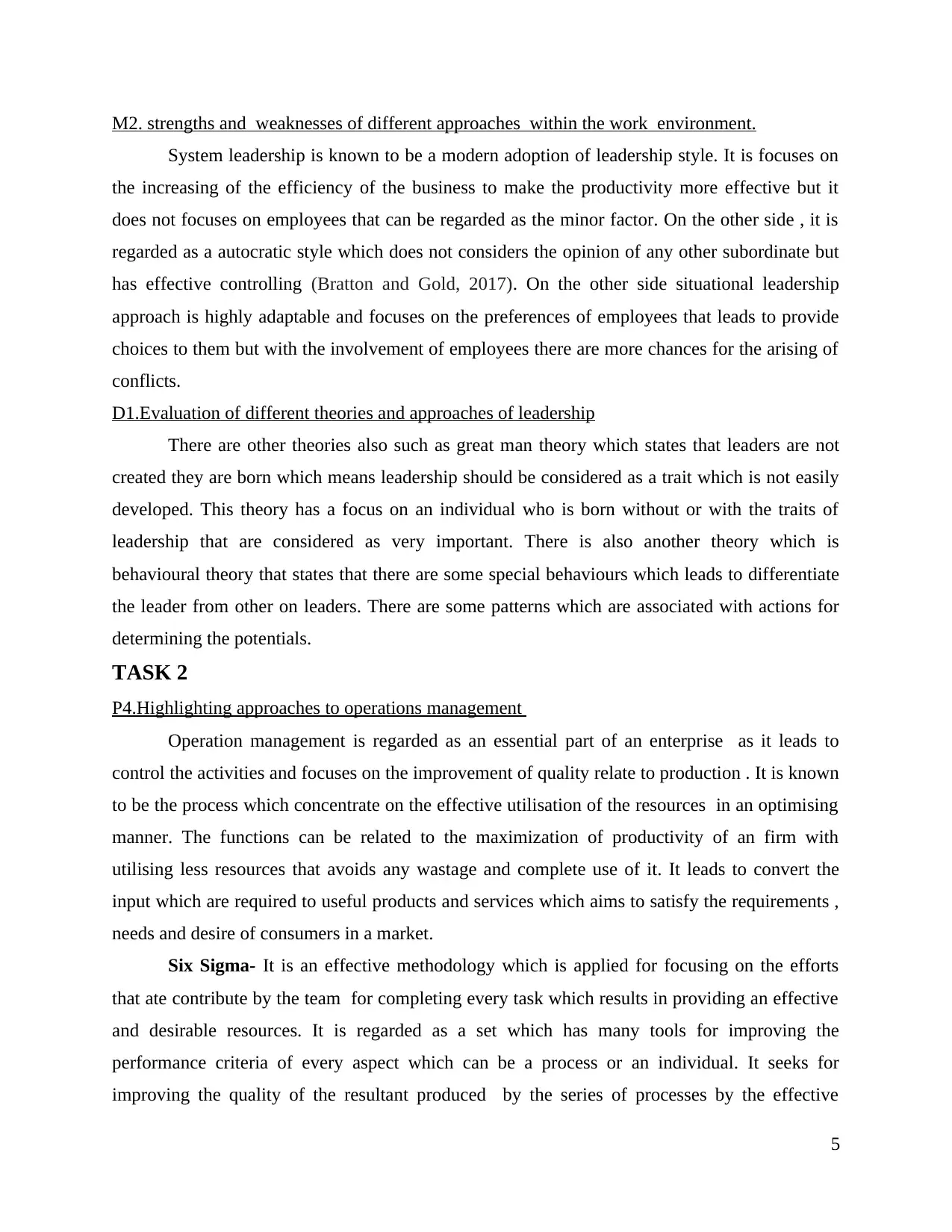
M2. strengths and weaknesses of different approaches within the work environment.
System leadership is known to be a modern adoption of leadership style. It is focuses on
the increasing of the efficiency of the business to make the productivity more effective but it
does not focuses on employees that can be regarded as the minor factor. On the other side , it is
regarded as a autocratic style which does not considers the opinion of any other subordinate but
has effective controlling (Bratton and Gold, 2017). On the other side situational leadership
approach is highly adaptable and focuses on the preferences of employees that leads to provide
choices to them but with the involvement of employees there are more chances for the arising of
conflicts.
D1.Evaluation of different theories and approaches of leadership
There are other theories also such as great man theory which states that leaders are not
created they are born which means leadership should be considered as a trait which is not easily
developed. This theory has a focus on an individual who is born without or with the traits of
leadership that are considered as very important. There is also another theory which is
behavioural theory that states that there are some special behaviours which leads to differentiate
the leader from other on leaders. There are some patterns which are associated with actions for
determining the potentials.
TASK 2
P4.Highlighting approaches to operations management
Operation management is regarded as an essential part of an enterprise as it leads to
control the activities and focuses on the improvement of quality relate to production . It is known
to be the process which concentrate on the effective utilisation of the resources in an optimising
manner. The functions can be related to the maximization of productivity of an firm with
utilising less resources that avoids any wastage and complete use of it. It leads to convert the
input which are required to useful products and services which aims to satisfy the requirements ,
needs and desire of consumers in a market.
Six Sigma- It is an effective methodology which is applied for focusing on the efforts
that ate contribute by the team for completing every task which results in providing an effective
and desirable resources. It is regarded as a set which has many tools for improving the
performance criteria of every aspect which can be a process or an individual. It seeks for
improving the quality of the resultant produced by the series of processes by the effective
5
System leadership is known to be a modern adoption of leadership style. It is focuses on
the increasing of the efficiency of the business to make the productivity more effective but it
does not focuses on employees that can be regarded as the minor factor. On the other side , it is
regarded as a autocratic style which does not considers the opinion of any other subordinate but
has effective controlling (Bratton and Gold, 2017). On the other side situational leadership
approach is highly adaptable and focuses on the preferences of employees that leads to provide
choices to them but with the involvement of employees there are more chances for the arising of
conflicts.
D1.Evaluation of different theories and approaches of leadership
There are other theories also such as great man theory which states that leaders are not
created they are born which means leadership should be considered as a trait which is not easily
developed. This theory has a focus on an individual who is born without or with the traits of
leadership that are considered as very important. There is also another theory which is
behavioural theory that states that there are some special behaviours which leads to differentiate
the leader from other on leaders. There are some patterns which are associated with actions for
determining the potentials.
TASK 2
P4.Highlighting approaches to operations management
Operation management is regarded as an essential part of an enterprise as it leads to
control the activities and focuses on the improvement of quality relate to production . It is known
to be the process which concentrate on the effective utilisation of the resources in an optimising
manner. The functions can be related to the maximization of productivity of an firm with
utilising less resources that avoids any wastage and complete use of it. It leads to convert the
input which are required to useful products and services which aims to satisfy the requirements ,
needs and desire of consumers in a market.
Six Sigma- It is an effective methodology which is applied for focusing on the efforts
that ate contribute by the team for completing every task which results in providing an effective
and desirable resources. It is regarded as a set which has many tools for improving the
performance criteria of every aspect which can be a process or an individual. It seeks for
improving the quality of the resultant produced by the series of processes by the effective
5
Paraphrase This Document
Need a fresh take? Get an instant paraphrase of this document with our AI Paraphraser
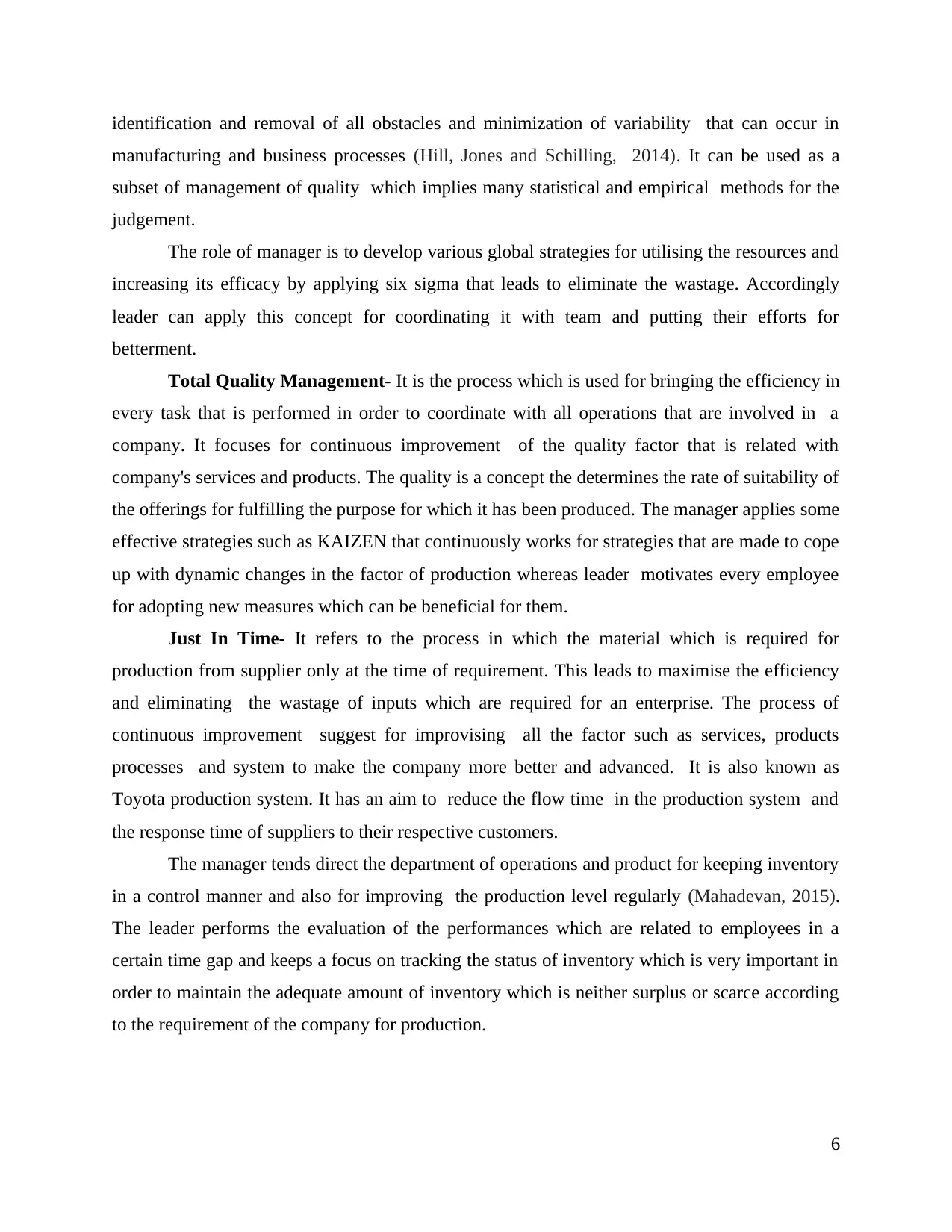
identification and removal of all obstacles and minimization of variability that can occur in
manufacturing and business processes (Hill, Jones and Schilling, 2014). It can be used as a
subset of management of quality which implies many statistical and empirical methods for the
judgement.
The role of manager is to develop various global strategies for utilising the resources and
increasing its efficacy by applying six sigma that leads to eliminate the wastage. Accordingly
leader can apply this concept for coordinating it with team and putting their efforts for
betterment.
Total Quality Management- It is the process which is used for bringing the efficiency in
every task that is performed in order to coordinate with all operations that are involved in a
company. It focuses for continuous improvement of the quality factor that is related with
company's services and products. The quality is a concept the determines the rate of suitability of
the offerings for fulfilling the purpose for which it has been produced. The manager applies some
effective strategies such as KAIZEN that continuously works for strategies that are made to cope
up with dynamic changes in the factor of production whereas leader motivates every employee
for adopting new measures which can be beneficial for them.
Just In Time- It refers to the process in which the material which is required for
production from supplier only at the time of requirement. This leads to maximise the efficiency
and eliminating the wastage of inputs which are required for an enterprise. The process of
continuous improvement suggest for improvising all the factor such as services, products
processes and system to make the company more better and advanced. It is also known as
Toyota production system. It has an aim to reduce the flow time in the production system and
the response time of suppliers to their respective customers.
The manager tends direct the department of operations and product for keeping inventory
in a control manner and also for improving the production level regularly (Mahadevan, 2015).
The leader performs the evaluation of the performances which are related to employees in a
certain time gap and keeps a focus on tracking the status of inventory which is very important in
order to maintain the adequate amount of inventory which is neither surplus or scarce according
to the requirement of the company for production.
6
manufacturing and business processes (Hill, Jones and Schilling, 2014). It can be used as a
subset of management of quality which implies many statistical and empirical methods for the
judgement.
The role of manager is to develop various global strategies for utilising the resources and
increasing its efficacy by applying six sigma that leads to eliminate the wastage. Accordingly
leader can apply this concept for coordinating it with team and putting their efforts for
betterment.
Total Quality Management- It is the process which is used for bringing the efficiency in
every task that is performed in order to coordinate with all operations that are involved in a
company. It focuses for continuous improvement of the quality factor that is related with
company's services and products. The quality is a concept the determines the rate of suitability of
the offerings for fulfilling the purpose for which it has been produced. The manager applies some
effective strategies such as KAIZEN that continuously works for strategies that are made to cope
up with dynamic changes in the factor of production whereas leader motivates every employee
for adopting new measures which can be beneficial for them.
Just In Time- It refers to the process in which the material which is required for
production from supplier only at the time of requirement. This leads to maximise the efficiency
and eliminating the wastage of inputs which are required for an enterprise. The process of
continuous improvement suggest for improvising all the factor such as services, products
processes and system to make the company more better and advanced. It is also known as
Toyota production system. It has an aim to reduce the flow time in the production system and
the response time of suppliers to their respective customers.
The manager tends direct the department of operations and product for keeping inventory
in a control manner and also for improving the production level regularly (Mahadevan, 2015).
The leader performs the evaluation of the performances which are related to employees in a
certain time gap and keeps a focus on tracking the status of inventory which is very important in
order to maintain the adequate amount of inventory which is neither surplus or scarce according
to the requirement of the company for production.
6
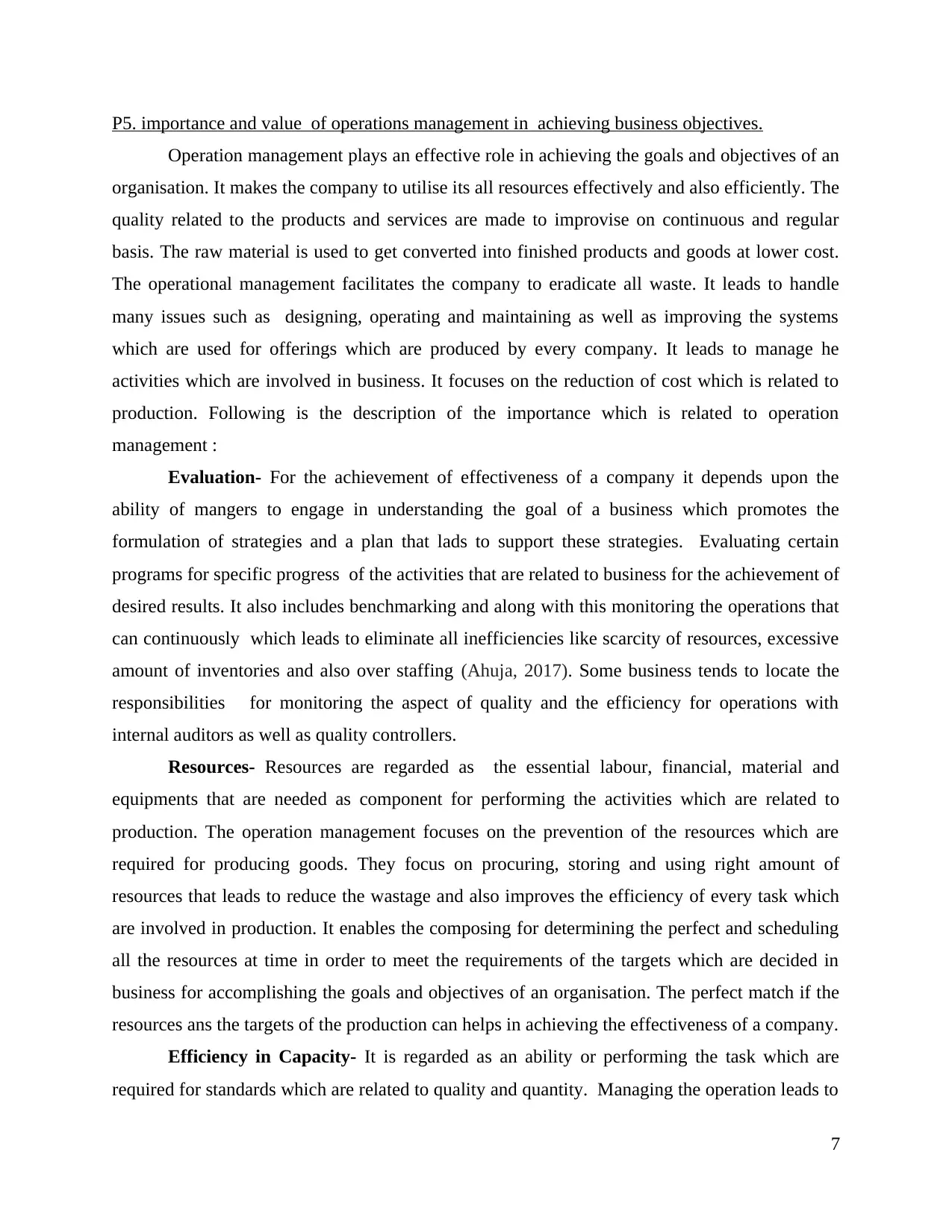
P5. importance and value of operations management in achieving business objectives.
Operation management plays an effective role in achieving the goals and objectives of an
organisation. It makes the company to utilise its all resources effectively and also efficiently. The
quality related to the products and services are made to improvise on continuous and regular
basis. The raw material is used to get converted into finished products and goods at lower cost.
The operational management facilitates the company to eradicate all waste. It leads to handle
many issues such as designing, operating and maintaining as well as improving the systems
which are used for offerings which are produced by every company. It leads to manage he
activities which are involved in business. It focuses on the reduction of cost which is related to
production. Following is the description of the importance which is related to operation
management :
Evaluation- For the achievement of effectiveness of a company it depends upon the
ability of mangers to engage in understanding the goal of a business which promotes the
formulation of strategies and a plan that lads to support these strategies. Evaluating certain
programs for specific progress of the activities that are related to business for the achievement of
desired results. It also includes benchmarking and along with this monitoring the operations that
can continuously which leads to eliminate all inefficiencies like scarcity of resources, excessive
amount of inventories and also over staffing (Ahuja, 2017). Some business tends to locate the
responsibilities for monitoring the aspect of quality and the efficiency for operations with
internal auditors as well as quality controllers.
Resources- Resources are regarded as the essential labour, financial, material and
equipments that are needed as component for performing the activities which are related to
production. The operation management focuses on the prevention of the resources which are
required for producing goods. They focus on procuring, storing and using right amount of
resources that leads to reduce the wastage and also improves the efficiency of every task which
are involved in production. It enables the composing for determining the perfect and scheduling
all the resources at time in order to meet the requirements of the targets which are decided in
business for accomplishing the goals and objectives of an organisation. The perfect match if the
resources ans the targets of the production can helps in achieving the effectiveness of a company.
Efficiency in Capacity- It is regarded as an ability or performing the task which are
required for standards which are related to quality and quantity. Managing the operation leads to
7
Operation management plays an effective role in achieving the goals and objectives of an
organisation. It makes the company to utilise its all resources effectively and also efficiently. The
quality related to the products and services are made to improvise on continuous and regular
basis. The raw material is used to get converted into finished products and goods at lower cost.
The operational management facilitates the company to eradicate all waste. It leads to handle
many issues such as designing, operating and maintaining as well as improving the systems
which are used for offerings which are produced by every company. It leads to manage he
activities which are involved in business. It focuses on the reduction of cost which is related to
production. Following is the description of the importance which is related to operation
management :
Evaluation- For the achievement of effectiveness of a company it depends upon the
ability of mangers to engage in understanding the goal of a business which promotes the
formulation of strategies and a plan that lads to support these strategies. Evaluating certain
programs for specific progress of the activities that are related to business for the achievement of
desired results. It also includes benchmarking and along with this monitoring the operations that
can continuously which leads to eliminate all inefficiencies like scarcity of resources, excessive
amount of inventories and also over staffing (Ahuja, 2017). Some business tends to locate the
responsibilities for monitoring the aspect of quality and the efficiency for operations with
internal auditors as well as quality controllers.
Resources- Resources are regarded as the essential labour, financial, material and
equipments that are needed as component for performing the activities which are related to
production. The operation management focuses on the prevention of the resources which are
required for producing goods. They focus on procuring, storing and using right amount of
resources that leads to reduce the wastage and also improves the efficiency of every task which
are involved in production. It enables the composing for determining the perfect and scheduling
all the resources at time in order to meet the requirements of the targets which are decided in
business for accomplishing the goals and objectives of an organisation. The perfect match if the
resources ans the targets of the production can helps in achieving the effectiveness of a company.
Efficiency in Capacity- It is regarded as an ability or performing the task which are
required for standards which are related to quality and quantity. Managing the operation leads to
7
⊘ This is a preview!⊘
Do you want full access?
Subscribe today to unlock all pages.

Trusted by 1+ million students worldwide
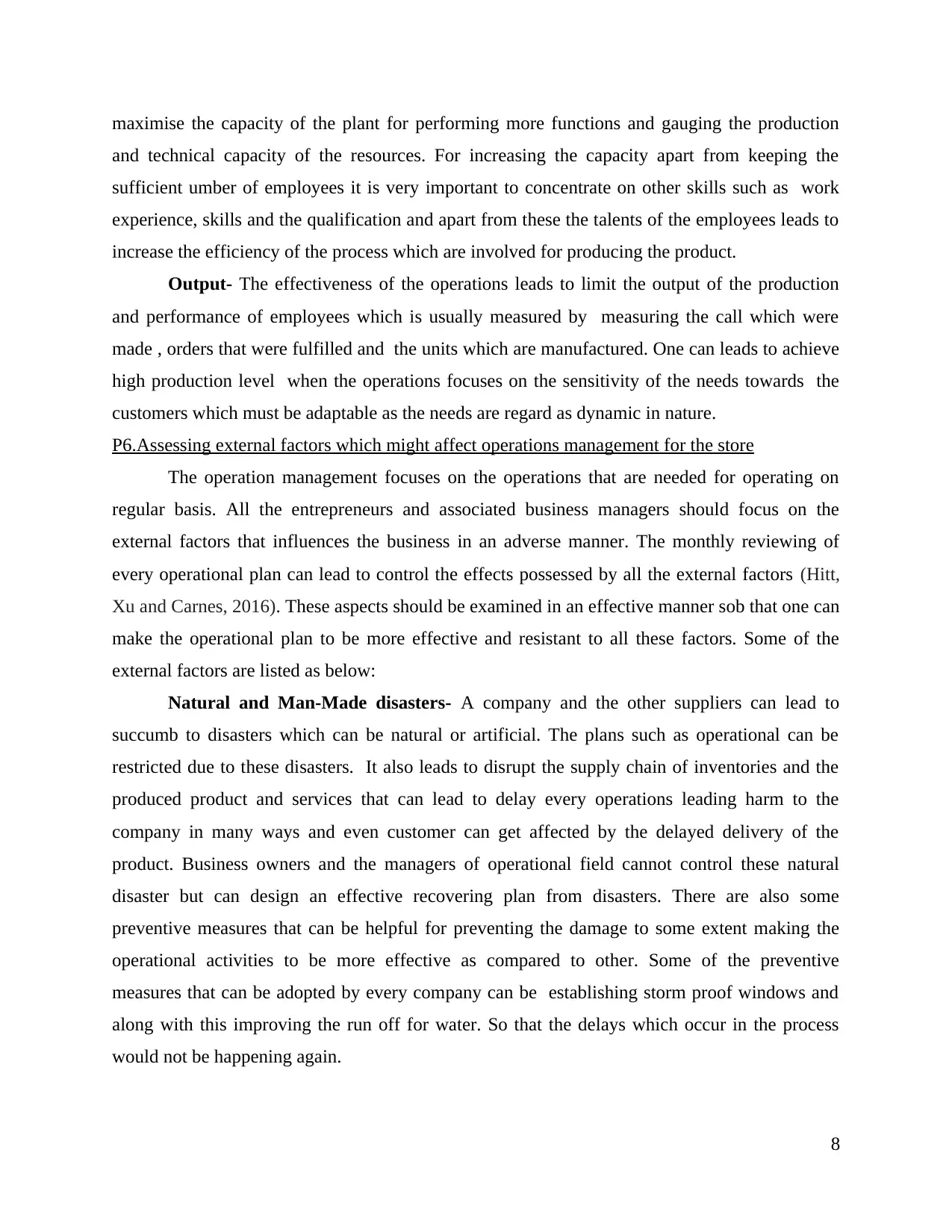
maximise the capacity of the plant for performing more functions and gauging the production
and technical capacity of the resources. For increasing the capacity apart from keeping the
sufficient umber of employees it is very important to concentrate on other skills such as work
experience, skills and the qualification and apart from these the talents of the employees leads to
increase the efficiency of the process which are involved for producing the product.
Output- The effectiveness of the operations leads to limit the output of the production
and performance of employees which is usually measured by measuring the call which were
made , orders that were fulfilled and the units which are manufactured. One can leads to achieve
high production level when the operations focuses on the sensitivity of the needs towards the
customers which must be adaptable as the needs are regard as dynamic in nature.
P6.Assessing external factors which might affect operations management for the store
The operation management focuses on the operations that are needed for operating on
regular basis. All the entrepreneurs and associated business managers should focus on the
external factors that influences the business in an adverse manner. The monthly reviewing of
every operational plan can lead to control the effects possessed by all the external factors (Hitt,
Xu and Carnes, 2016). These aspects should be examined in an effective manner sob that one can
make the operational plan to be more effective and resistant to all these factors. Some of the
external factors are listed as below:
Natural and Man-Made disasters- A company and the other suppliers can lead to
succumb to disasters which can be natural or artificial. The plans such as operational can be
restricted due to these disasters. It also leads to disrupt the supply chain of inventories and the
produced product and services that can lead to delay every operations leading harm to the
company in many ways and even customer can get affected by the delayed delivery of the
product. Business owners and the managers of operational field cannot control these natural
disaster but can design an effective recovering plan from disasters. There are also some
preventive measures that can be helpful for preventing the damage to some extent making the
operational activities to be more effective as compared to other. Some of the preventive
measures that can be adopted by every company can be establishing storm proof windows and
along with this improving the run off for water. So that the delays which occur in the process
would not be happening again.
8
and technical capacity of the resources. For increasing the capacity apart from keeping the
sufficient umber of employees it is very important to concentrate on other skills such as work
experience, skills and the qualification and apart from these the talents of the employees leads to
increase the efficiency of the process which are involved for producing the product.
Output- The effectiveness of the operations leads to limit the output of the production
and performance of employees which is usually measured by measuring the call which were
made , orders that were fulfilled and the units which are manufactured. One can leads to achieve
high production level when the operations focuses on the sensitivity of the needs towards the
customers which must be adaptable as the needs are regard as dynamic in nature.
P6.Assessing external factors which might affect operations management for the store
The operation management focuses on the operations that are needed for operating on
regular basis. All the entrepreneurs and associated business managers should focus on the
external factors that influences the business in an adverse manner. The monthly reviewing of
every operational plan can lead to control the effects possessed by all the external factors (Hitt,
Xu and Carnes, 2016). These aspects should be examined in an effective manner sob that one can
make the operational plan to be more effective and resistant to all these factors. Some of the
external factors are listed as below:
Natural and Man-Made disasters- A company and the other suppliers can lead to
succumb to disasters which can be natural or artificial. The plans such as operational can be
restricted due to these disasters. It also leads to disrupt the supply chain of inventories and the
produced product and services that can lead to delay every operations leading harm to the
company in many ways and even customer can get affected by the delayed delivery of the
product. Business owners and the managers of operational field cannot control these natural
disaster but can design an effective recovering plan from disasters. There are also some
preventive measures that can be helpful for preventing the damage to some extent making the
operational activities to be more effective as compared to other. Some of the preventive
measures that can be adopted by every company can be establishing storm proof windows and
along with this improving the run off for water. So that the delays which occur in the process
would not be happening again.
8
Paraphrase This Document
Need a fresh take? Get an instant paraphrase of this document with our AI Paraphraser
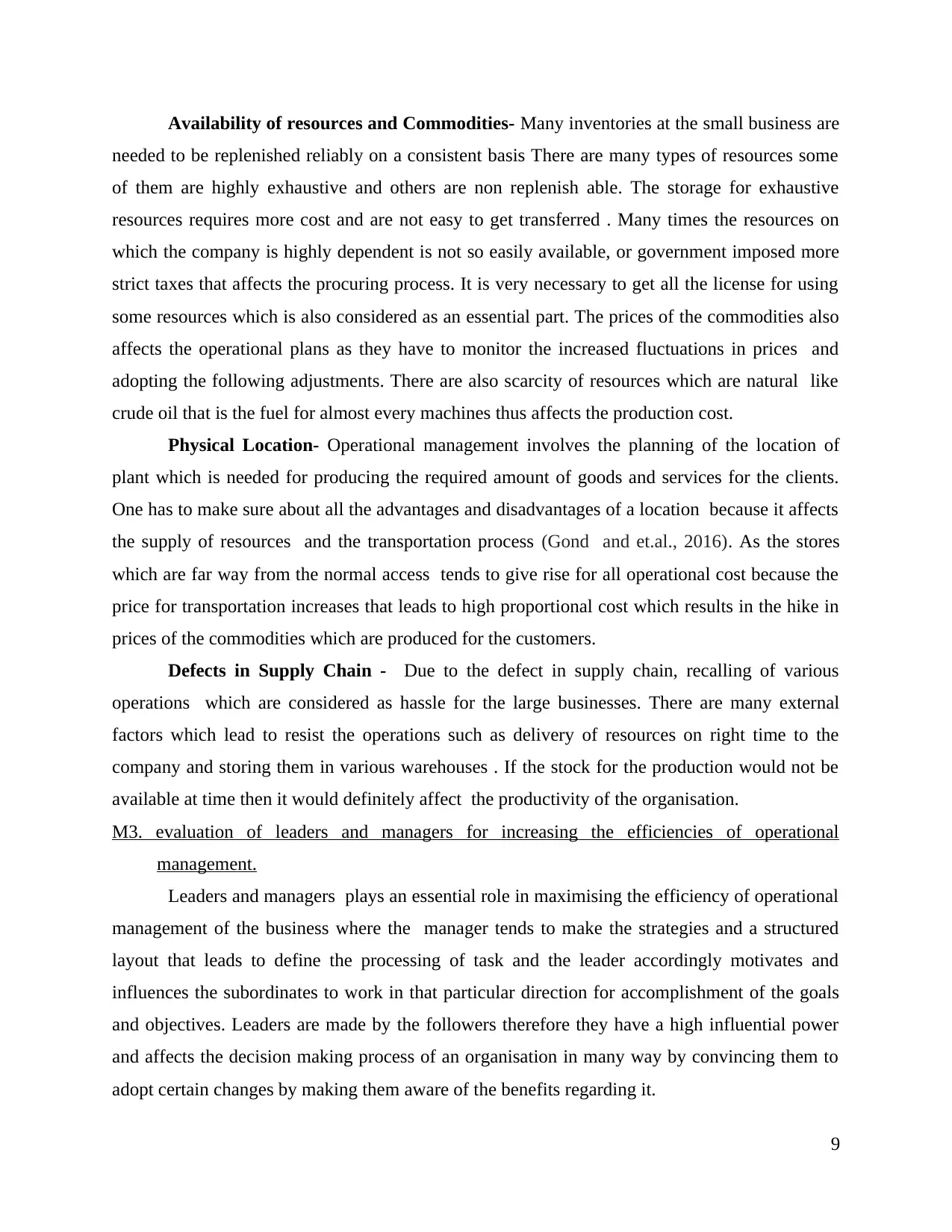
Availability of resources and Commodities- Many inventories at the small business are
needed to be replenished reliably on a consistent basis There are many types of resources some
of them are highly exhaustive and others are non replenish able. The storage for exhaustive
resources requires more cost and are not easy to get transferred . Many times the resources on
which the company is highly dependent is not so easily available, or government imposed more
strict taxes that affects the procuring process. It is very necessary to get all the license for using
some resources which is also considered as an essential part. The prices of the commodities also
affects the operational plans as they have to monitor the increased fluctuations in prices and
adopting the following adjustments. There are also scarcity of resources which are natural like
crude oil that is the fuel for almost every machines thus affects the production cost.
Physical Location- Operational management involves the planning of the location of
plant which is needed for producing the required amount of goods and services for the clients.
One has to make sure about all the advantages and disadvantages of a location because it affects
the supply of resources and the transportation process (Gond and et.al., 2016). As the stores
which are far way from the normal access tends to give rise for all operational cost because the
price for transportation increases that leads to high proportional cost which results in the hike in
prices of the commodities which are produced for the customers.
Defects in Supply Chain - Due to the defect in supply chain, recalling of various
operations which are considered as hassle for the large businesses. There are many external
factors which lead to resist the operations such as delivery of resources on right time to the
company and storing them in various warehouses . If the stock for the production would not be
available at time then it would definitely affect the productivity of the organisation.
M3. evaluation of leaders and managers for increasing the efficiencies of operational
management.
Leaders and managers plays an essential role in maximising the efficiency of operational
management of the business where the manager tends to make the strategies and a structured
layout that leads to define the processing of task and the leader accordingly motivates and
influences the subordinates to work in that particular direction for accomplishment of the goals
and objectives. Leaders are made by the followers therefore they have a high influential power
and affects the decision making process of an organisation in many way by convincing them to
adopt certain changes by making them aware of the benefits regarding it.
9
needed to be replenished reliably on a consistent basis There are many types of resources some
of them are highly exhaustive and others are non replenish able. The storage for exhaustive
resources requires more cost and are not easy to get transferred . Many times the resources on
which the company is highly dependent is not so easily available, or government imposed more
strict taxes that affects the procuring process. It is very necessary to get all the license for using
some resources which is also considered as an essential part. The prices of the commodities also
affects the operational plans as they have to monitor the increased fluctuations in prices and
adopting the following adjustments. There are also scarcity of resources which are natural like
crude oil that is the fuel for almost every machines thus affects the production cost.
Physical Location- Operational management involves the planning of the location of
plant which is needed for producing the required amount of goods and services for the clients.
One has to make sure about all the advantages and disadvantages of a location because it affects
the supply of resources and the transportation process (Gond and et.al., 2016). As the stores
which are far way from the normal access tends to give rise for all operational cost because the
price for transportation increases that leads to high proportional cost which results in the hike in
prices of the commodities which are produced for the customers.
Defects in Supply Chain - Due to the defect in supply chain, recalling of various
operations which are considered as hassle for the large businesses. There are many external
factors which lead to resist the operations such as delivery of resources on right time to the
company and storing them in various warehouses . If the stock for the production would not be
available at time then it would definitely affect the productivity of the organisation.
M3. evaluation of leaders and managers for increasing the efficiencies of operational
management.
Leaders and managers plays an essential role in maximising the efficiency of operational
management of the business where the manager tends to make the strategies and a structured
layout that leads to define the processing of task and the leader accordingly motivates and
influences the subordinates to work in that particular direction for accomplishment of the goals
and objectives. Leaders are made by the followers therefore they have a high influential power
and affects the decision making process of an organisation in many way by convincing them to
adopt certain changes by making them aware of the benefits regarding it.
9
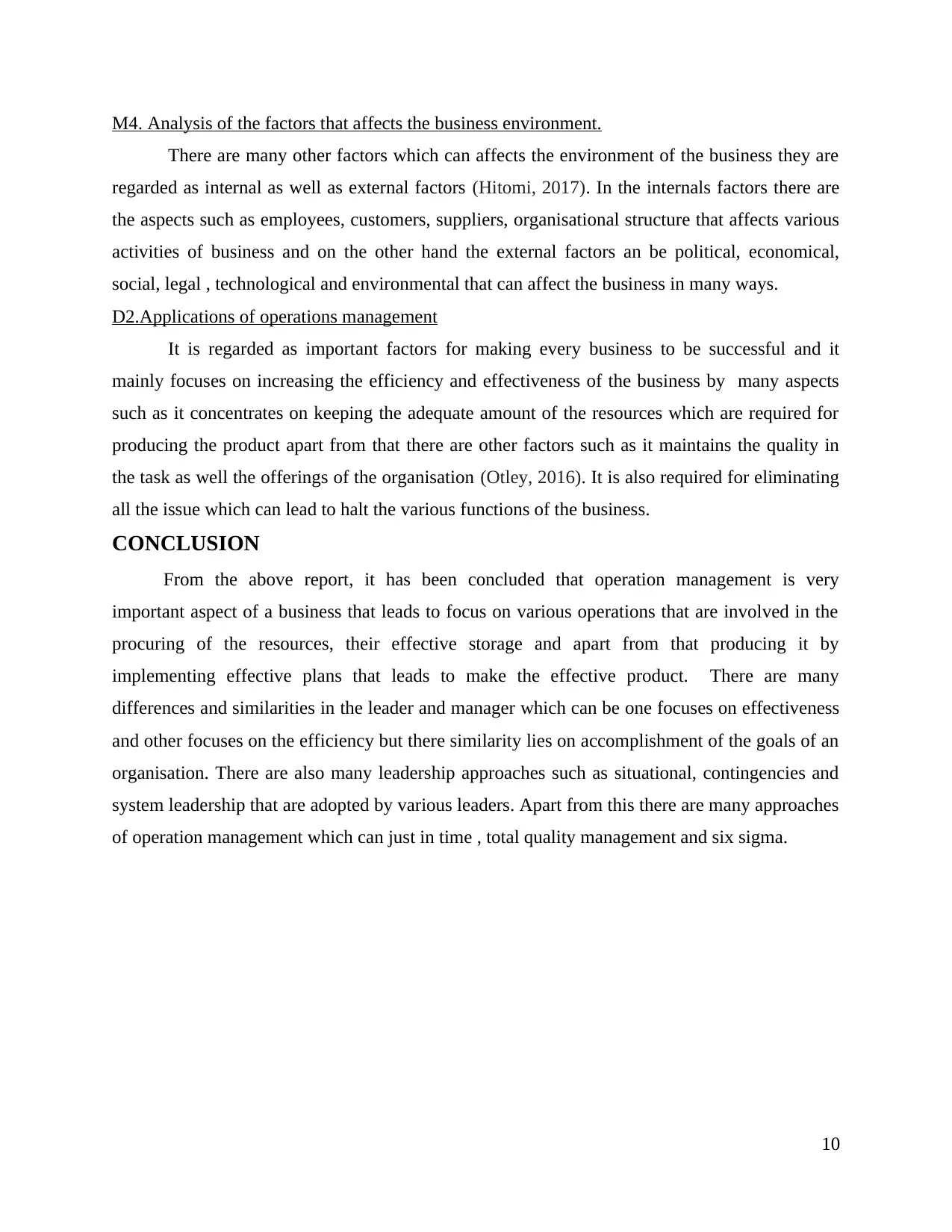
M4. Analysis of the factors that affects the business environment.
There are many other factors which can affects the environment of the business they are
regarded as internal as well as external factors (Hitomi, 2017). In the internals factors there are
the aspects such as employees, customers, suppliers, organisational structure that affects various
activities of business and on the other hand the external factors an be political, economical,
social, legal , technological and environmental that can affect the business in many ways.
D2.Applications of operations management
It is regarded as important factors for making every business to be successful and it
mainly focuses on increasing the efficiency and effectiveness of the business by many aspects
such as it concentrates on keeping the adequate amount of the resources which are required for
producing the product apart from that there are other factors such as it maintains the quality in
the task as well the offerings of the organisation (Otley, 2016). It is also required for eliminating
all the issue which can lead to halt the various functions of the business.
CONCLUSION
From the above report, it has been concluded that operation management is very
important aspect of a business that leads to focus on various operations that are involved in the
procuring of the resources, their effective storage and apart from that producing it by
implementing effective plans that leads to make the effective product. There are many
differences and similarities in the leader and manager which can be one focuses on effectiveness
and other focuses on the efficiency but there similarity lies on accomplishment of the goals of an
organisation. There are also many leadership approaches such as situational, contingencies and
system leadership that are adopted by various leaders. Apart from this there are many approaches
of operation management which can just in time , total quality management and six sigma.
10
There are many other factors which can affects the environment of the business they are
regarded as internal as well as external factors (Hitomi, 2017). In the internals factors there are
the aspects such as employees, customers, suppliers, organisational structure that affects various
activities of business and on the other hand the external factors an be political, economical,
social, legal , technological and environmental that can affect the business in many ways.
D2.Applications of operations management
It is regarded as important factors for making every business to be successful and it
mainly focuses on increasing the efficiency and effectiveness of the business by many aspects
such as it concentrates on keeping the adequate amount of the resources which are required for
producing the product apart from that there are other factors such as it maintains the quality in
the task as well the offerings of the organisation (Otley, 2016). It is also required for eliminating
all the issue which can lead to halt the various functions of the business.
CONCLUSION
From the above report, it has been concluded that operation management is very
important aspect of a business that leads to focus on various operations that are involved in the
procuring of the resources, their effective storage and apart from that producing it by
implementing effective plans that leads to make the effective product. There are many
differences and similarities in the leader and manager which can be one focuses on effectiveness
and other focuses on the efficiency but there similarity lies on accomplishment of the goals of an
organisation. There are also many leadership approaches such as situational, contingencies and
system leadership that are adopted by various leaders. Apart from this there are many approaches
of operation management which can just in time , total quality management and six sigma.
10
⊘ This is a preview!⊘
Do you want full access?
Subscribe today to unlock all pages.

Trusted by 1+ million students worldwide
1 out of 15
Related Documents
Your All-in-One AI-Powered Toolkit for Academic Success.
+13062052269
info@desklib.com
Available 24*7 on WhatsApp / Email
![[object Object]](/_next/static/media/star-bottom.7253800d.svg)
Unlock your academic potential
Copyright © 2020–2025 A2Z Services. All Rights Reserved. Developed and managed by ZUCOL.





